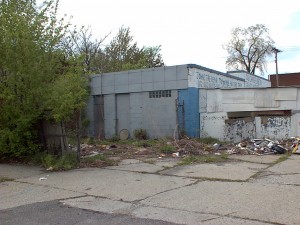By Sarah Coefield, coefield@msu.edu
Great Lakes Echo
Aug. 13, 2009

Plants may be particularly well-suited to helping suck contamination from sites of abandoned gas stations. Photo: Michigan Department of Environmental Quality
Some Great Lakes brownfields will turn green if Congress passes a $475 million restoration package.
Literally.
The U.S. Forest Service seeks $2 million of the Great Lakes Restoration Initiative to transform unusable industrial lots into parks and trailways – and clean up some contaminants in the process.
While the forest service has long restored natural vegetation and has an urban forestry division, this will be its first foray into phytoremediation, said Steven Davis, a watershed specialist with the forest service’s Northeastern Area State and Private Forestry division.
Phytoremediation relies on trees, shrubs and grasses to naturally break down and remove contaminants from soil and groundwater.
Brownfields are burdened with an array of contaminants – leftovers from old gas stations, machine shops and dry cleaners. Traditional cleanup of these chemicals can run into the hundreds of thousands of dollars, said Ron Smedley, the brownfield redevelopment coordinator with the Michigan Department of Environmental Quality. Costs add up quickly when heavily contaminated soil is hauled away and treated off-site. The trade-off is a quick fix and a space that can be reoccupied by new businesses.
But without pressing development needs, a brownfield can sit empty indefinitely, Smedley said.
In those cases, plants can be a cheap alternative to hauling and treating soil.
“Sometimes it makes good sense when you have a brownfield site that doesn’t have much money to clean it up, but has some time,” said Steve Rock, an environmental engineer with the EPA Office of Research and Development. Rock has written several articles and reports about plants restoring contaminated soils. “A lot of brownfields don’t have a sort of immediate use to them, so they have a certain amount of time that can be used for cleaning them up,” he said.
And for phytoremediation, time is an essential ingredient. The process can take years. Decades, even. Root systems have to spread to reach the contaminants, and the process of removing or breaking down the chemicals can be slow.
The upside is that it’s cheap. The Forest Service can plant an acre for $1,000, although the price goes up for planting older trees, Davis said.
Another advantage is that the area becomes usable even before cleanup is complete. “Once you put a green cover on a brownfield, a lot of the exposure pathways get more or less covered up,” Rock said. “If you can keep the contaminant under vegetation, people can usually use the site … for casual recreation fairly quickly.”
That community use makes transforming brownfields all the more attractive to the forest service.
“It’s not only for toxics take up,” Davis said. “It’s also for restoring these sites and getting them more productive … restoring urban forests on areas that aren’t really being used for anything.”
If the restoration initiative passes, the forest service will start lining up projects in the fall. The grant process will be available for non-profits and local, state, and federal organizations that want to restore brownfields, Davis said.
Pingback: Urban pioneers turn vacant lots verdant | Great Lakes Echo